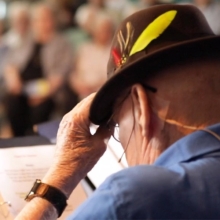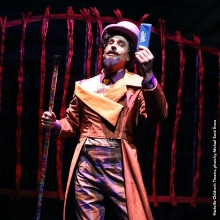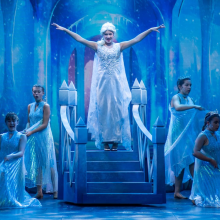Show History
History
Inspiration
Ragtime is based on E.L. Doctorow's epic novel of the same name. In 1994, Canadian theatrical producer Garth Drabinsky secured permission to musicalize Doctorow's story. Published in 1975, Ragtime, the novel, is historical fiction inspired by actual events in New York City at the turn of the twentieth century. Real historical figures such as Emma Goldman, Henry Ford, J.P. Morgan, Evelyn Nesbit and Harry Houdini all feature prominently in both the novel and the musical.
Productions
Ragtime first opened in Toronto in December of 1996. The show featured a score by songwriters Lynn Ahrens and Stephen Flaherty, a book by veteran playwright Terrence McNally, direction by Frank Galati and choreography by Graciela Daniele. The first American production premiered in Los Angeles in June of 1997, where work continued. The show finally arrived on Broadway on January 18, 1998, christening the brand-new Ford Center for the Performing Arts. The legendary original cast included Brian Stokes Mitchell as Coalhouse Walker, Jr.; Audra McDonald as Sarah; Marin Mazzie as Mother; Peter Friedman as Tateh and Judy Kaye as Emma Goldman.
Subsequent to its Broadway run, Ragtime received two national tours. In 2003, the London production, which presented the show on a more intimate scale, opened to great acclaim, earning eight Olivier nominations.
In 2009, the John F. Kennedy Center for the Performing Arts staged a technically pared-down version of the show, and that production moved to Broadway's Neil Simon Theatre. Previews began October 23, 2009, and the show officially opened on November 15, 2009. The revival cast featured Stephanie Umoh (Sarah), Quentin Earl Darrington (Coalhouse Walker, Jr.), Christiane Noll (Mother), Robert Petkoff (Tateh), Bobby Steggert (Younger Brother), Donna Migliaccio (EmmaGoldman) and Ron Bohmer (Father). The production was directed and choreographed by Marcia Milgrom Dodge. This was the first Broadway revival of Ragtime and the first Broadway revival of any 1990s musical. Although the production opened to critical acclaim, the show closed on January 10, 2010, after 28 previews and 65 performances.
Cultural Influence
- Ragtime is frequently produced around the country in many acclaimed productions, including one particularly innovative production, which employed eight actors and puppets!
- The title Ragtime comes from the musical style of the same name, which was a uniquely American, syncopated musical phenomenon that swept the country in the late nineteenth- and early twentieth centuries.
Trivia
- When Garth Drabinsky secured the rights to E.L. Doctorow's novel, he took an unorthodox approach to find the songwriting team. He auditioned various composers and lyricists, asking them to create a four-song demo tape. After listening to the nine or ten submissions, Doctorow, Drabinsky and bookwriter Terrence McNally, were in complete agreement that lyricist Lynn Ahrens and composer Stephen Flaherty were the perfect team to write the score. (Amazingly, three of the four songs on Ahrens and Flaherty's original demo tape remained in the show: "Ragtime," "Gliding" and "'Til We Reach That Day.")
- Ragtime initially garnered thirteen Tony Award nominations, the most of any show that season, and won four – Best Score, Best Book, Best Orchestrations and Best Supporting Actress (Audra McDonald). It also received thirteen Drama Desk nominations that same year, as well as six Olivier Nominations in 2004.
- Lea Michele, of TV's "Glee: and Broadway's Spring Awakening, played the Little Girl in the original Broadway production of Ragtime.
- After a successful workshop of Ragtime in Toronto, prior to the 1996 opening, a concept recording of the show was released.




